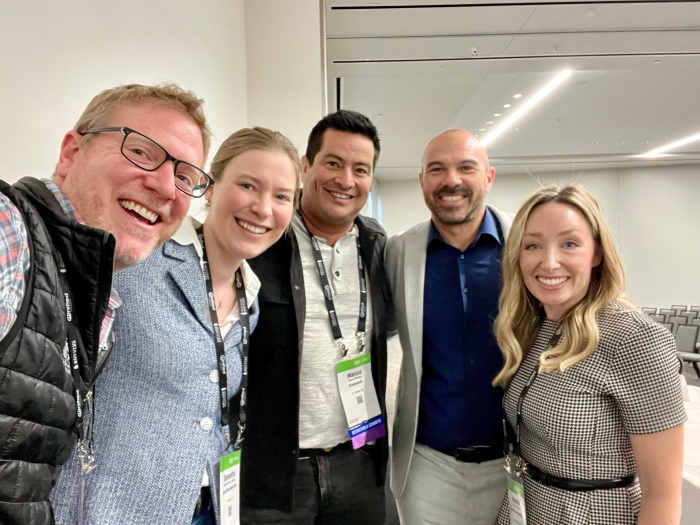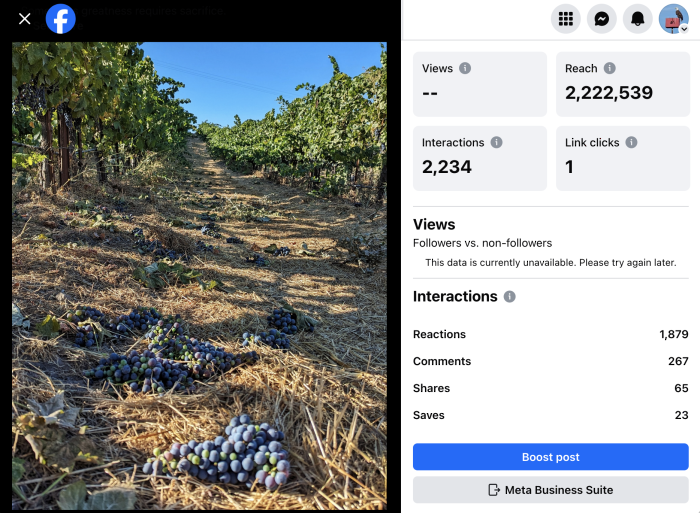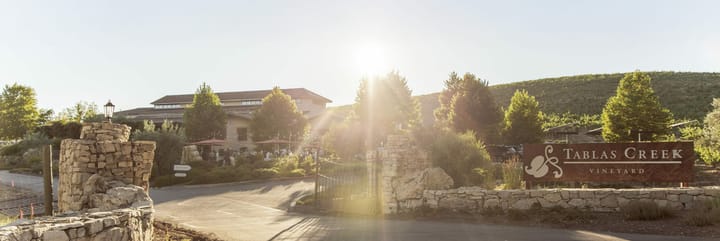Lessons from My "Be Your Own Influencer" Panel This Week
This past week I made the long drive up to Sacramento to be a part of a panel at the California wine community's most important trade show, the Unified Grape and Wine Symposium. The panel was titled "Be Your Own Influencer" and was organized and moderated by superstar somm and (yes) influencer Amanda McCrossin, aka @sommvivant. Joining me on the panel was a great cross-section of wineries (and one writer) who Amanda had flagged for doing a good job of creating follow-worthy content. From left, after me, Samantha Cole-Johnson of JancisRobinson.com, Marcus Marquez of Brasswood in Napa Valley, Damian Doffo of Doffo Winery and MotoDoffo in Temecula, and Amanda herself.

The panel discussion was terrific. I was taking notes myself as I was listening to the other members of the panel share their approaches, their challenges, and their surprises. That's one of the things that I love about the wine community: its openness to sharing what works. I think that's in part because of the sort of people who wine attracts as a career, but it's also helped by the fact that wine isn't a zero-sum product. Hardly any wine lovers buy from just one winery. So helping another winery do better doesn't make a customer less likely to buy from you. In fact, I've always thought that if someone buys wine from one of our neighbors, or someone else in the Rhone community, or someone who farms regeneratively, that makes them more likely to buy from Tablas Creek. That makes it easy to want to participate on panels like these.
Now that I've had a few days to reflect on the panel, I thought it might be interesting -- and potentially even helpful -- if I shared a few of my take-home lessons. These are, in essence, the things I've come to believe are important if a winery wants to be successful in social media. Some of these are probably intuitive and we've been trying to implement them for years, but others are ideas that were crystallized by the discussions before and during the panel. While I'm intending these for other members of the wine community, there's very little that's wine-specific so they are hopefully applicable to a wide range of consumer-facing businesses.
- Be authentically you. If there was one most important message of the panel, it was this. Amanda began by asking the audience to think about how they say hello to customers and guests in person, and then to think about if that's consistent with what they do online. I hadn't thought about it in exactly that way before, but ultimately, that's what social media does at its best. It personalizes a business. It shares the experience of a product with people who might not be able to be there in person. And there are as many ways to do this as there are personality types. Some wineries (Brasswood was a great example of this) lean into humor. Others (like Doffo, with their connection to motorcycles) lean into adventure. Others, like us, lean into education. And there must be dozens of other approaches that work. But any good approach will be authentic to who you are as a brand.
- Include at least some video content. People connect to other people. And there's no better way to have your personality come through than on video. This doesn't mean that it's the right approach to only produce video content. That might work for some influencers, but it's probably not going to be right for a business. Video can be a lot of work to produce, and there is certain content that neither requires or benefits from it. But if a business is putting together nothing but still photos or carousels, it's probably not going to be doing a great job of personalizing itself. The social media algorithms also prioritize video content in many situations. Amanda was quick to point out that no one feels comfortable on video at first, and not to let that scare you off. I can second that. But there's nothing like talking to your audience. It's worth pushing through that initial discomfort.
- Don't feel you need to make it polished. Related to the last point, all the panelists agreed that you didn't need to be producing something that felt glossy. That doesn't mean that it's fine to post things that are sloppy or inaccurate. We all talked about the value of scheduling tools and having someone else on our teams to read and edit the work that we put together. And Sam was quick to point out that her own content, which represents an iconic journalistic outlet, needed to be fact-checked and edited even before she sits down to film her weekly segment. But the audience wants to connect with you. If your content comes across as slick, that can make it harder to relate to. Similarly, that's why obviously staged photos (think the ubiquitous "wine still life") tend to do less well in social media feeds than posts that feel more like they could be plucked from the audience's lives.
- Post regularly. There isn't a hard and fast rule here. We were the only winery on the panel that makes a point to post something every day. But you want to be consistent. You wouldn't reach out to a friend twice a week and then go dark for a month. A good post a few times a week is a great start, and within the capabilities of pretty much any business. That said, I would advocate for posting at least every other day. Most users check their social media daily, at least. You're competing for mind share, and you lose a little bit of that share each day you don't have content in the feeds your customer is scrolling through.
- Collaborate. You wouldn't want to spend much time with a friend who only talked about themselves, would you? So figure out ways to create content that becomes a conversation. Maybe that's a joint post with another winery, or a writer, or an attraction. Maybe it's an Instagram Live conversation like the series that I started when Covid shut down all our traditional ways of interacting with our customers. Maybe it's something like our monthly #OurSLOCounty series where we ask our team to share three local wineries, one restaurant, and one activity that they love. There's a reason that people call it the "wine community". We're all a part of an infrastructure that includes other wineries as well as restaurants, shops, attractions, and trends. Take advantage of the social media tools, especially on Instagram, that allow collaborative posts and show those posts to both accounts' audiences.
- Interact. We made a commitment a few years ago to acknowledge every comment that we received on all our social media platforms. That's something I see done consistently on most of the best social media accounts I follow. On the one hand, it's simple politeness. But it's also a powerful way to continue personalizing your business. It's not without its time costs, but if it takes us, with our 75,000 followers across four major platforms, a few hours per week, it's within the capabilities of just about any business. I'd add that we've found great value in sharing posts (or stories) that mention us in our stories. Doing so builds your audience, rewards the people who have taken the time to mention you, and is likely to lead to them re-sharing these posts and further bringing new eyes to your feed.
- Come up with relevant series. If this all sounds daunting, I encourage you to think about putting together series that allow you to cycle through content without having to come up with a half-dozen new ideas each week. Some of the series that we've done at Tablas Creek over the last few years (for which we typically try to create a hashtag so people can find the collection from whichever one they first stumble across, and which they can choose to follow if they want) include:
- The #ConversationWithJason series I mentioned earlier of my Instagram Live conversations with people around the world of wine (roughly every 2-3 weeks, ongoing)
- The #OurSLOCounty series where we ask our team to share their favorites (monthly, ongoing)
- The #TablasOnTour series where we share the events we'll be participating in (monthly, ongoing)
- The new #DogsOfTablas series where we'll be sharing photos and profiles of the many canine members of the Tablas Creek team (monthly, just getting started)
- The periodic explainer series where I share something cool that I've found in the vineyard or winery, or where I answer a question I've been getting recently (irregular)
- The #GrapeMinute video series where I distill one minute of essentials on each of the 19 grapes that we grow at Tablas Creek (weekly, late 2022-early 2023)
- The #GrapeLoveLetter series where we shared the history, growing tendencies, winemaking specifics, flavor profile, and uses of our grapes (weekly, 2021)
- Don't chase virality. This may seem counter-intuitive. After all, don't you want your post shown to thousands (or millions) of potential new fans? But Amanda's advice resonated with our experience. It's often unpredictable what will go viral. The people to whom your viral post is shown may not have a ton of overlap with your target audience or be familiar with your brand. And the post that does go viral may well not be something that would be your choice to introduce people to you. I had the chance to share the example of the below Facebook post of a cluster that we'd thinned to ensure the others would ripen (with the caption "sometimes greatness requires sacrifice") that ended up being shown to more than 2 million accounts. The first 10,000 or so were our fans, which was great. But then it ended up way outside of our audience and attracted lots of comments like "what a waste starving people all over the world" and "All this for alcohol, what a waste of space food and resources." Instead of going for virality, Amanda suggested that wineries think about being as useful and as interesting as possible to their fans. That makes a lot of sense to me.

I'm curious: if you're a part of a winery's social media team, what do you think of this list? If you're a follower of wineries (and if you're reading this, you're a follower of at least one) what do you find most compelling and valuable? We all want to find ways to make wine a more regular and more valued part of people's lives. Social media is likely to be one of the most powerful tools in our collective toolkit.

